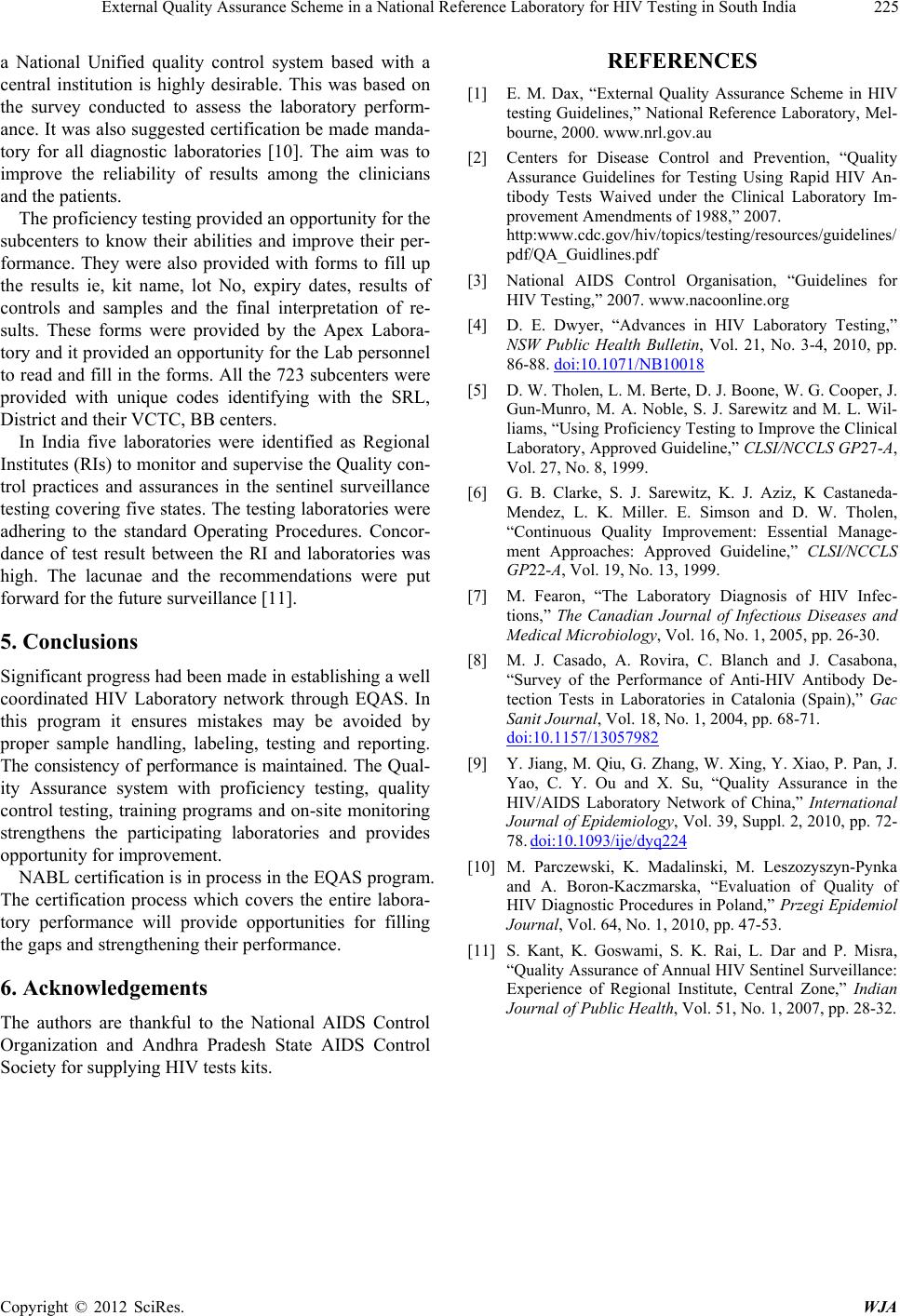
External Quality Assurance Scheme in a National Reference Laboratory for HIV Testing in South India
Copyright © 2012 SciRes. WJA
225
a National Unified quality control system based with a
central institution is highly desirable. This was based on
the survey conducted to assess the laboratory perform-
ance. It was also suggested certification be made manda-
tory for all diagnostic laboratories [10]. The aim was to
improve the reliability of results among the clinicians
and the patients.
The proficiency testing provided an opportunity for the
subcenters to know their abilities and improve their per-
formance. They were also provided with forms to fill up
the results ie, kit name, lot No, expiry dates, results of
controls and samples and the final interpretation of re-
sults. These forms were provided by the Apex Labora-
tory and it provided an opportunity for the Lab personnel
to read and fill in the forms. All the 723 subcenters were
provided with unique codes identifying with the SRL,
District and their VCTC, BB centers.
In India five laboratories were identified as Regional
Institutes (RIs) to monitor and supervise the Quality con-
trol practices and assurances in the sentinel surveillance
testing covering five states. The testing laboratories were
adhering to the standard Operating Procedures. Concor-
dance of test result between the RI and laboratories was
high. The lacunae and the recommendations were put
forward for the future surveillance [11].
5. Conclusions
Significant progress had been made in establishing a well
coordinated HIV Laboratory network through EQAS. In
this program it ensures mistakes may be avoided by
proper sample handling, labeling, testing and reporting.
The consistency of performance is maintained. The Qual-
ity Assurance system with proficiency testing, quality
control testing, training programs and on-site monitoring
strengthens the participating laboratories and provides
opportunity for improvement.
NABL certification is in process in the EQAS program.
The certification process which covers the entire labora-
tory performance will provide opportunities for filling
the gaps and strengthening their performance.
6. Acknowledgements
The authors are thankful to the National AIDS Control
Organization and Andhra Pradesh State AIDS Control
Society for supplying HIV tests kits.
REFERENCES
[1] E. M. Dax, “External Quality Assurance Scheme in HIV
testing Guidelines,” National Reference Laboratory, Mel-
bourne, 2000. www.nrl.gov.au
[2] Centers for Disease Control and Prevention, “Quality
Assurance Guidelines for Testing Using Rapid HIV An-
tibody Tests Waived under the Clinical Laboratory Im-
provement Amendments of 1988,” 2007.
http:www.cdc.gov/hiv/topics/testing/resources/guidelines/
pdf/QA_Guidlines.pdf
[3] National AIDS Control Organisation, “Guidelines for
HIV Testing,” 2007. www.nacoonline.org
[4] D. E. Dwyer, “Advances in HIV Laboratory Testing,”
NSW Public Health Bulletin, Vol. 21, No. 3-4, 2010, pp.
86-88. doi:10.1071/NB10018
[5] D. W. Tholen, L. M. Berte, D. J. Boone, W. G. Cooper, J.
Gun-Munro, M. A. Noble, S. J. Sarewitz and M. L. Wil-
liams, “Using Proficiency Testing to Improve the Clinical
Laboratory, Approved Guideline,” CLSI/NCCLS GP27-A,
Vol. 27, No. 8, 1999.
[6] G. B. Clarke, S. J. Sarewitz, K. J. Aziz, K Castaneda-
Mendez, L. K. Miller. E. Simson and D. W. Tholen,
“Continuous Quality Improvement: Essential Manage-
ment Approaches: Approved Guideline,” CLSI/NCCLS
GP22-A, Vol. 19, No. 13, 1999.
[7] M. Fearon, “The Laboratory Diagnosis of HIV Infec-
tions,” The Canadian Journal of Infectious Diseases and
Medical Microbiology, Vol. 16, No. 1, 2005, pp. 26-30.
[8] M. J. Casado, A. Rovira, C. Blanch and J. Casabona,
“Survey of the Performance of Anti-HIV Antibody De-
tection Tests in Laboratories in Catalonia (Spain),” Gac
Sanit Journal, Vol. 18, No. 1, 2004, pp. 68-71.
doi:10.1157/13057982
[9] Y. Jiang, M. Qiu, G. Zhang, W. Xing, Y. Xiao, P. Pan, J.
Yao, C. Y. Ou and X. Su, “Quality Assurance in the
HIV/AIDS Laboratory Network of China,” International
Journal of Epidemiology, Vol. 39, Suppl. 2, 2010, pp. 72-
78. doi:10.1093/ije/dyq224
[10] M. Parczewski, K. Madalinski, M. Leszozyszyn-Pynka
and A. Boron-Kaczmarska, “Evaluation of Quality of
HIV Diagnostic Procedures in Poland,” Przegi Epidemiol
Journal, Vol. 64, No. 1, 2010, pp. 47-53.
[11] S. Kant, K. Goswami, S. K. Rai, L. Dar and P. Misra,
“Quality Assurance of Annual HIV Sentinel Surveillance:
Experience of Regional Institute, Central Zone,” Indian
Journal of Public Health, Vol. 51, No. 1, 2007, pp. 28-32.